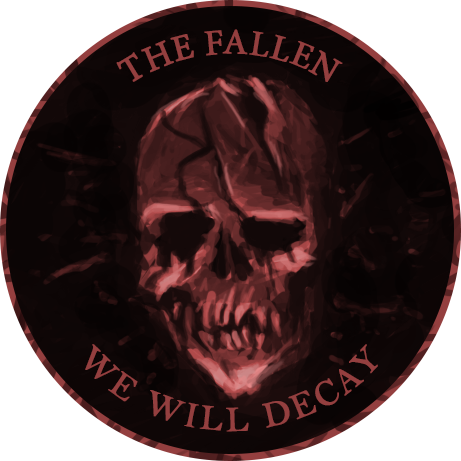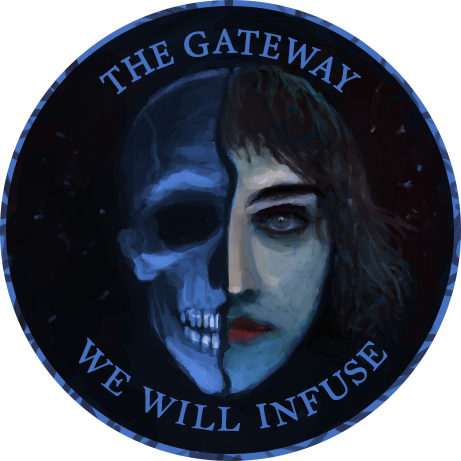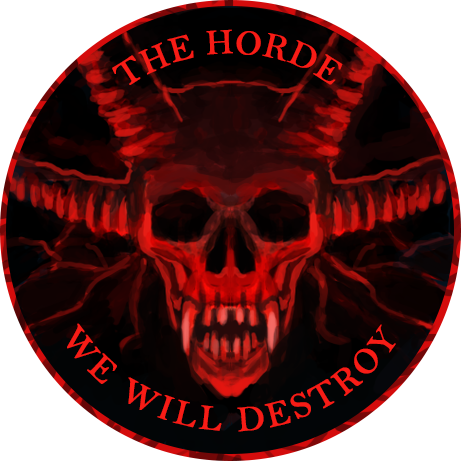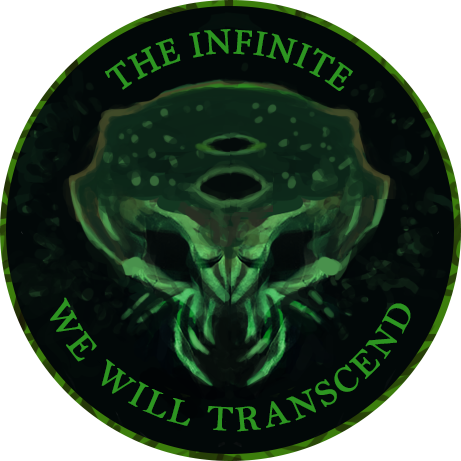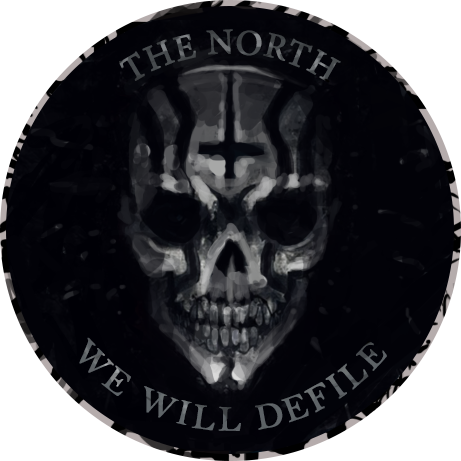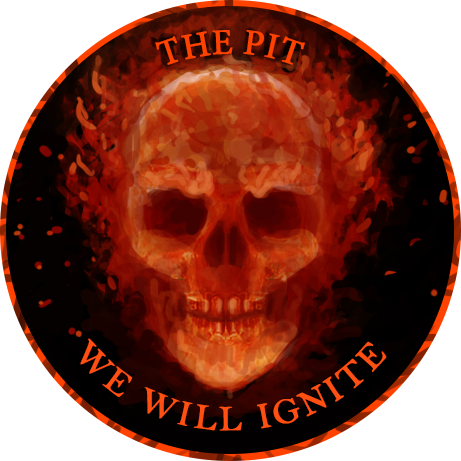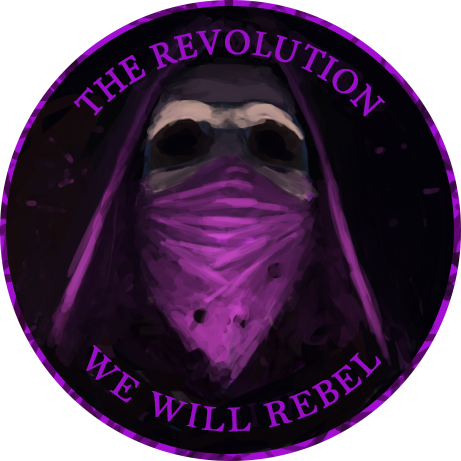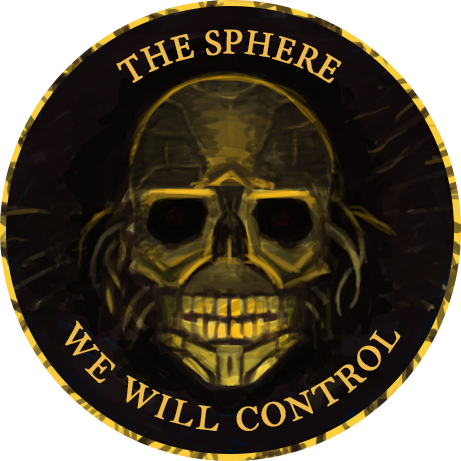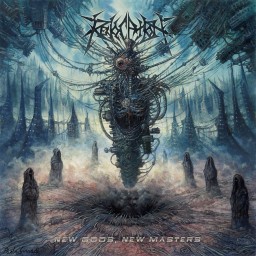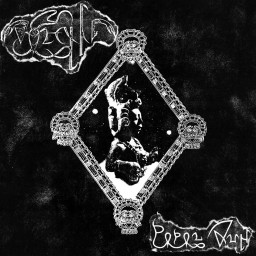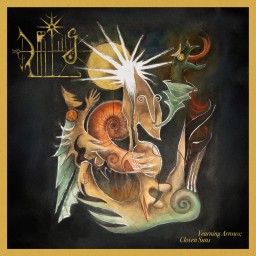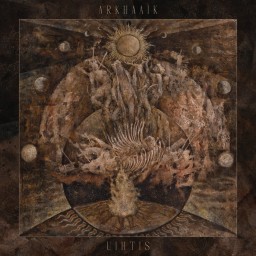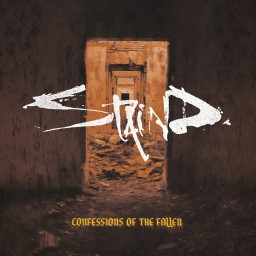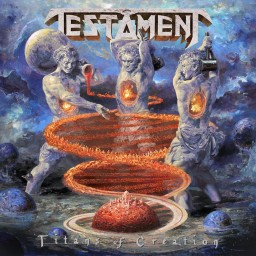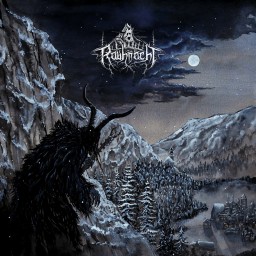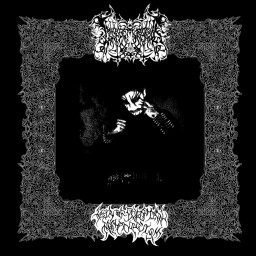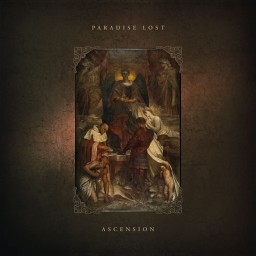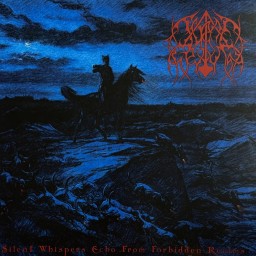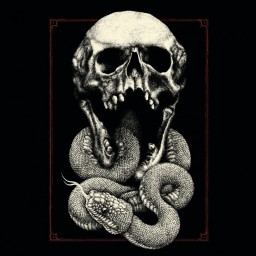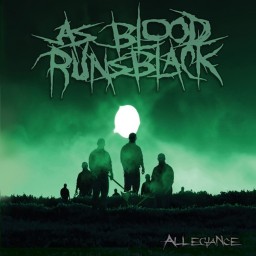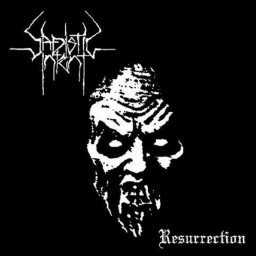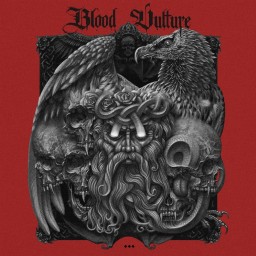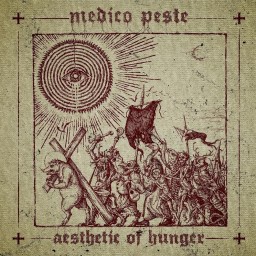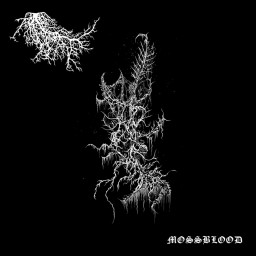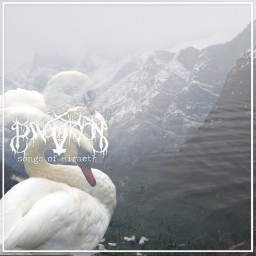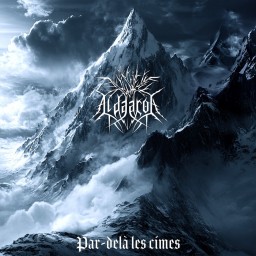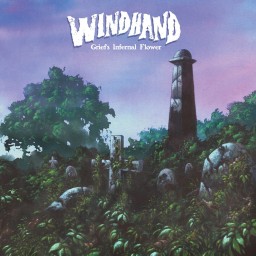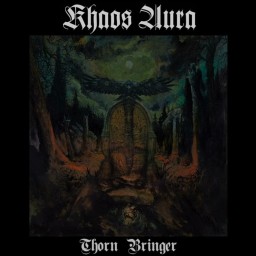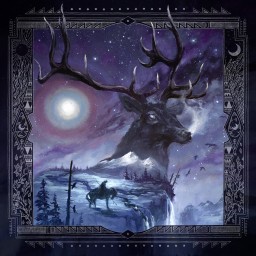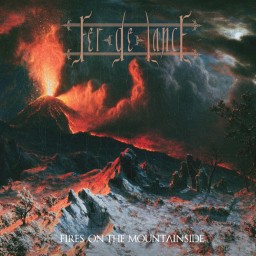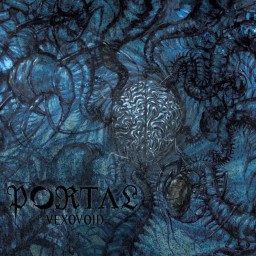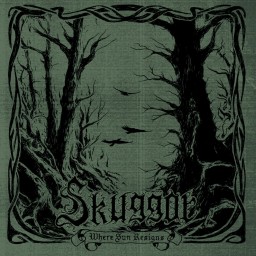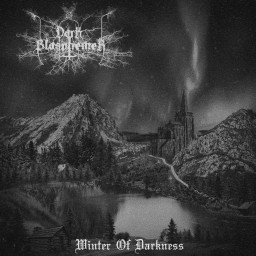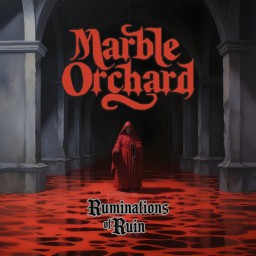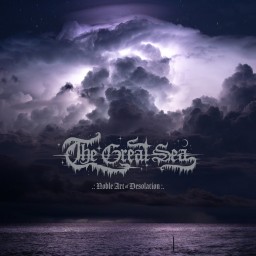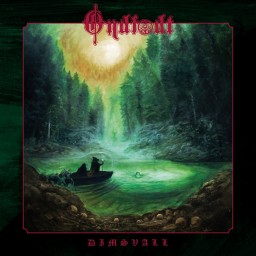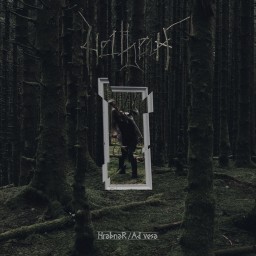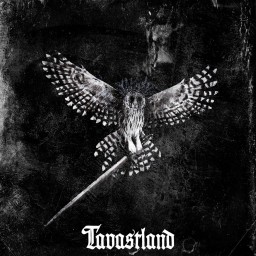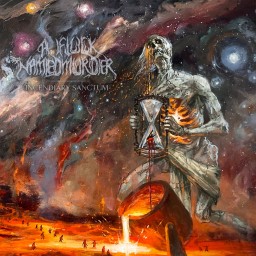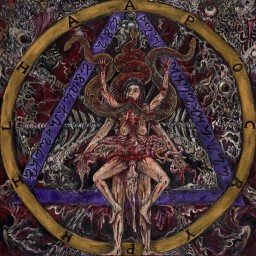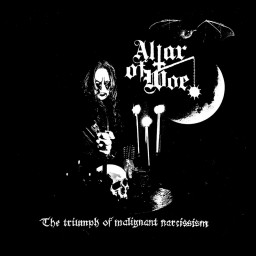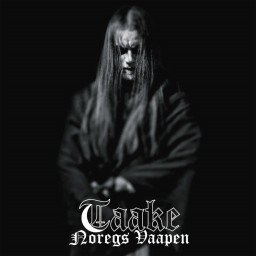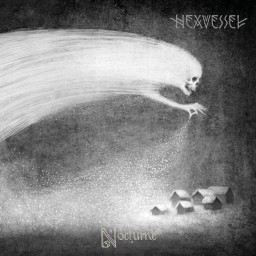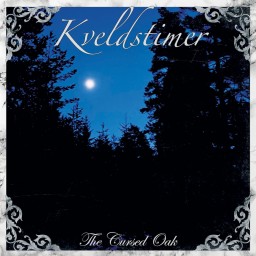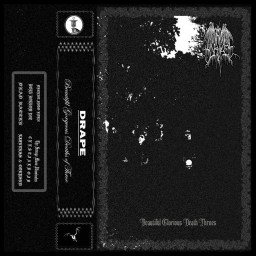Vinny's Reviews
New Gods, New Masters is one of only a handful of death metal albums that I have entertained over the course of 2025. In a year that has only seen me focus on death doom as part of my discovery of new music in The Fallen clan, conventional, technical and progressive death metal has not been on high rotation over the past twelve months. If I am honest, Revocation hadn’t piqued my interest with any of the previous releases I had heard, although I cannot say with hand on heart that I recall listening to a full length of theirs in recent history. It was upon hearing the chug fest that is ‘Confines of Infinity’ on an interview with Dave Davidson that my ears pricked up to the promise of some hard-hitting death metal. Seeing that one of my death metal heroes, Luc Lemay was making an appearance only enhanced my urge to give New Gods, New Masters a listen.
Now, I cannot pretend to be a massive fan of technical death metal. Despite owning all Death albums on physical format, I do have to be in a particular mood to put on Individual Thought Patterns, for example. Whilst my guard was up going into this Revocation record, having heard many times how proficient a player DD is and fully expecting an expansive wank fest as a result, I was surprised at how riffy New Gods, New Masters is. Even the technical and progressive mastery is difficult to not be impressed with, to the point where my admiration even extends to acknowledging who well controlled those potentially alien elements are throughout the album. I will not pretend some of those dashing and clipped riffs that kick off ‘Sarcophagi of the Soul’ do not irritate me though, and I much prefer it when the track settles into more rhythmic territory.
Guests appear to have been queuing up to perform on the album with the likes of Travis Ryan (Cattle Decapitation), Jonny Davy (Job for a Cowboy), Luc Lemay (Gorguts) and even jazz guitarist, Gilad Hekselman making contributions to the proceedings. Surprisingly for me, it is Travis’ track that I find the most appealing of all. ‘Confines of Infinity’ has an infectious, hacking riff to it that contrasts with the more chaotic main parts to the track which also makes good use of some groovy riffs to temper the song back to that main riff. Leads/solos all have a crispness to them, and they benefit from the production job of DD, as you would perhaps expect. I am not as enamoured with the drum sound though, that instrument sounds a bit lost in the mix. The presence of Ash Pearson is still, somehow, unquestionable despite this injustice, and he gives a good acquittal of himself regardless.
I am pleased I found so much to enjoy from this record. It proves that there is still some interest in death metal for me beyond the confines of the more gloomy and funeral doom styles that I have focused on more this year. Retaining some of their death thrash elements of old most certainly has helped me with being able to connect so easily with this record also. The longevity factor remains in question for me, but for now I will just enjoy it whilst it lasts.
Genres: Death Metal
Format: Album
Year: 2025
Popol Vuh is a total sonic assault on the senses for those who dare to delve into this latest release from the renowned main persona of the Black Twilight Circle, Eduardo “Volahn” Ramirez. It is a complex blend of atmospherics, scathing black metal and indigenous sounds that can be traced back to the Mesoamerican civilisation, the Mayans. Sang entirely in Spanish, these six tracks leave very little room for breath, charging at the listener with an unrelenting fury that is as dizzying as it is terrifying. Popol Vuh is quite the disorientating experience at first, and it took a couple of listens for me to grasp what was going on and understand that despite the raging intensity of the pace, it is a well-balanced record.
This is an album that sounds evil. Reminiscent of the smothering soundscapes of Akhlys at times, Popol Vuh has its roots embedded in the true extreme foundations of the black metal genre. From a guitar perspective, it rarely involves melody when it comes to laying down the grounds of its attack. Favouring acoustics for any requirement to bring the record into less offensive sounding territory, it is the use of native instruments that really sets the sound apart from probably most of what the average black metal fan has heard so far this year. Couple all of this with the icy sonics of Paysage d’hiver and you soon come to an understanding of the quality on offer here.
Absolutely resolute in its Mexican nationalism, this album commemorates “the anniversary of the Spanish defeat at the hands of the triumphant Guatemalan warriors” and heralds “the twilight of Mexican Independence”. The sound of the album portrays superbly the tumult of the history it shares and is delivered with a clear passion. There is a sense of mastery to the album that usually comes when the traditional instrumentation of an ancient civilisation is played so well alongside such an extreme facet of music as it is here. There is almost an astral element to Popol Vuh that I was not expecting to hear at the outset and as such it is an album that has caught me off guard in terms of how much I have ended up enjoying it.
Genres: Black Metal
Format: Album
Year: 2025
The loosely described “experimental black metal” of Arrows offers a different side to the Jünger Tumilon music collective that explores a much darker aesthetic. Retaining those death doom elements also, Yearning Arrows; Cloven Suns still packs a hefty punch and infuses this brevity of riffs with a level of horror atmospherics to really mix things up. It is hard not to be terrified at various points of ‘At War with Peace’, blending tribal elements with more progressive elements and a driving rhythm too boot, this is a massive track on what is only a(nother) four track release. The clean vocals that are used here fit perfectly into the menacing fade of the track, suggesting this battle is still ongoing long after the record is finished.
Arrows have synths and they are not afraid to use them. Stabbing atmospherics into songs like devilishly sharp blades into flesh, they accompany the guitars perfectly whilst building tension well at the same time. The main point of interest in the sound of Arrows though is the bellicose vocal style that gets used intermittently throughout the record. Clean vocals can be made to sound threatening and this approach is a perfect example of this being done to good effect. I did find this element to be leaning on the too quirky side of things at first. However, I soon found them to be more of a unique identifier in the sound of the album. Darvish and Menetekel share vocal duties, cleverly giving this variety into proceedings without making it sound forced as I suspect it would if one vocalist tried to flex their style.
It is clear to hear Arkhaaik in Arrows, given that all three band members on Yearning Arrows; Cloven Suns are the exact same trio who put together Uihtis this year. What a wonderfully busy and experimental 2025 these three are having. Of the two records, this one shades the other (albeit marginally) as it presents much more directly. Whereas Uihtis relies a lot more on build up, this Arrows release manages to retain that same element of mystery whilst being able to express more of a bloodlust in how it is presented. The experimental tag does not mean a multitude of instruments either, similarly I can also allay any fears of sprawling structures of endless spoken word inserts (thankfully). Despite its clear progressive tendencies, this record retains an earthiness to it still and comes out very near the top of the pile of releases this year. It is The Fallen clan that this one should definitely reside in still, its monolithic pace is still the core of the sound after all.
Genres: Black Metal Doom Metal Progressive Metal
Format: Album
Year: 2025
Jünger Tumilon is described as a musical collective from Switzerland. What it appears to mean is that most of the band that make up the collective all share members or are involved in multiple projects that make up the collective. It’s like a Kibbutz for fucked up music basically. The trio that makes up Arkhaaik all conform to this multi-faceted approach to band membership, with no fewer than eleven different, active bands being listed as containing members of Arkhaaik. Described as blackened doom by at least one reviewer on Bandcamp, they certainly do not conform to any norm when it comes to their sound.
Whilst I would perhaps challenge the blackened element as being that prominent in their sound, there is no question on the doom front when it comes to Uihtis. Riffs are thick and atmospheres often thicker, the tribal aspects to the sound invoking as much mystery into proceedings as they do heaviness. The theme of the album is a Bronze Age hunt, obviously; aren’t all good metal albums themed on this after all? Except the album goes beyond the mere act of hunting and the ceremonial slaughter of an animal and adopts the concept for half of the album of the sun hunting the moon and vice-versa. Did you follow that? Keep up, folks.
Joking aside, Uihtis is not half as bonkers as I expected it to be. The chanting vocals that expand tracks beyond the gruff approach that is generally deployed do fit well in terms of furthering that transcendental aspect to the record. Where those mining black metal riffs do get to stretch their legs, they bring some element of dashing menace to proceedings. Yet in the main, Uihtis is structured on strong percussion and rhythmic riffing to drive the message home. Arkhaaik’s sound is the marching of foot soldiers, not as an army, more as resistance fighters. A small, yet capable band of warriors, relentless in their pursuit of their prey, regardless of whether it be man or beast.
With no track being under ten minutes, the band have lots of time to fill and thankfully their approach to song writing rewards the listener. Cleverly balancing the use of atmosphere and instrumentation to build and temper tracks appropriately, I soon found myself absorbed into tracks such as the mesmerising ‘Hrkþos Heshr Hiagom’. The structure changes regularly enough on this track to keep it interesting without losing momentum or the sense of intrigue either. This is the main reason for the success of Uihtis, it is varied without feeling like it is just lots of things thrown into a studio mix for the hell of it. It won’t make many end of year lists probably as there is more than enough content here to alienate a hardened metalhead. Yet it should be recognised for its ingenuity alone. My advice is to look beyond the length of the tracks and settle into the content.
Genres: Black Metal Doom Metal
Format: Album
Year: 2025
As alternative metal goes, Confessions of the Fallen has been a neat find over the past week for me. Triggered by some algorithm somewhere, the 2024 deluxe edition fell into my recommendations and here I am, five days on, writing a review. As I read back my review of 2001’s Break the Cycle it is interesting that my thoughts are largely still the same when it comes to a record that has come out circa twenty-two years after that album. Clearly a trademark of the band, that depressive, self-loathing, over-thinking, underachieving and sullen take on life is once again at the forefront of the twelve tracks that make up the record. Such an expression of feelings is not wrong by any means. Indeed, when they hone it appropriately, it works well to produce memorable, catchy and emotionally taut songs. However, just like it was in 2001, here in 2025 (accepting the album came out in 2023) it becomes a bit of a slog after four or five tracks.
Thankfully, the better tracks are interspersed amongst the filler well enough in terms of arrangement to make the album more than palatable. After a strong opening three tracks, the power ballad ‘Here and Now’ presents the first of the infectious, written for the big screen moment. Sarcasm aside, it is a great track, and I can’t stop playing it, so fair play Aaron and co. Similarly, ‘Better Days’ follows a simple format with a memorable dictation of the chorus line to ensure hooks are firmly embedded in the brain. Confessions of the Fallen is not just about bleating ballads and overly expressive vocals though, when Staind riff on this thing they truly drop the weight on the listener, and for me it has more impact than any of the lyrics or arrangements. The album opens with ‘Lowest in Me’ which shows the teeth of the band early on deploying some core mentality towards the final third of the track. The title track is probably the heaviest of these moments, it’s implied darkness from the lyrics borne out in the crushing riffs that are present on the track also.
The filler does bring the score down, however. ‘Cycle of Hurting’ with its electro pulses and more nu-metal ethos just stands out as an obvious dud to me. Likewise, ‘Full of Emptiness’ has an almost laughable level of clunkiness to it and should have been left for a B-side compilation at some point in the future. Ending on a positive note though, there is a grit to Aaron’s vocals nowadays that does provide some mature edge to proceedings (much needed at times) and for all my gripes, the album has grown on me since I first picked it up. This is rare for this sub-genre as it represents one of the smaller percentages of my collection overall, so fair play once again guys.
Genres: Alternative Metal
Format: Album
Year: 2023
Sometimes albums just slip by you, don’t they? Whilst I would not class myself as an avid fan of Testament exactly, I do have a few of their albums and made a purchase of Formation of Damnation on vinyl in the last twelve months. Yet somehow Titans of Creation slipped by me unnoticed. I could say “more or less” unnoticed because now I have gone back to my catalogue Excel spreadsheet I can see that I rated this record at three out of five, which could suggest an average album, or (given that I never transferred that rating onto Metal Academy) more likely that it was a holding score until I could find time to give the record a critical listen. News today that a new album is in the offing, in a year that has little in the way of quality releases stacking up in The Pit clan, brought this album from five years ago back onto my radar.
The fact is, Titans of Creation is a great thrash metal record. I would go as far as to say Testament’s best since 2008’s Formation… album that I enjoyed so much I made a physical purchase of it. Following the mediocre Dark Roots of Earth and the flat sounding Brotherhood of the Snake, Titans… is a much more dynamic sounding record. Opening strongly with the racing ‘Children of the Next Level’ I immediately sensed that the band indeed had upped their game to the next level in a literal sense. The guitars and vocals especially sound like they have a burning hunger to them, the lead work is nothing short of exceptional at times which is something that has been missing for too long on Testament records. ‘Dreamer Deceiver’ is brilliant in this regard and it is a toss up between this track and ‘False Prophet’ for which is my standout moment on the record.
Inevitably almost, with twelve tracks in play, there are some blunted moments where the razor-sharp nature of what we have heard overall gets the edge taken off it. After a solid first half of the record, things do get a little patchy thereafter, but they never go into full on filler mode thankfully. Whilst it may not always translate into fluid thrashing music, the energy levels behind it rarely abate and that is so refreshing to hear from a band at this stage of their career. The outro to the record seems particularly pointless in the grand scheme of things but I still find it forgivable if a few less-than-ideal moments slip through due to clear overexuberance on the bands part. If they can carry this enthusiasm through into Para Bellum later this week then I personally be a very happy chappy.
Genres: Thrash Metal
Format: Album
Year: 2020
As the Burzum chimes grow heavier on 'Der Spalt zwischen den Welten' ('the gap between worlds') there is a sense that Rauhnåcht's fifth full length has arrived. I am very much a fan of that particular trait from the Filosofem album, so any use of that sound can only be a good thing in my book. For a band/artist that is advertised as pagan black metal, it was a bit of a surprise to hear ambient chimes, yet it fits the track aesthetic perfectly. There are other influences on show as well, such as the illusions of grandeur of Summoning or the earthy fortitude of Drudkh.
Zwischenwelten (‘between worlds’) is music for times of adversity. Acting as a balm with its soothing atmospheres yet also providing strength and hope in the chants and resonating tremolo riffs. As an album it has a succinctness in how it plays for just under forty-minutes, as if the artist is taking brief respite from some daily labour to share tales of mysticism and dark fantasy. As the album artwork alludes to, there is a darkness to the album that dress its contents as a warning, a collection of tales of what exactly it is that lurks in that gap between worlds; without ever stating which worlds are being spoken about.
Although less direct in approach than Drudkh, the timbre of the guitar matches on track such as ‘Naturgewalten’ (‘forces of nature’) as it builds up to full speed. Cleverly applying atmospherics in the vacant space around the instruments is well done. As with the album overall, the pagan/folk elements are obvious but never intrusive and as such Zwischenwelten feels like a more conventional black metal album than at first expected. I think the release is only let down by the fact that it lacks any genuine standout moments though. There is no raging intensity that takes the breath away at any point, nor any passages of true ethereal beauty to reflect upon either. Closing track ‘Alleinsamkeit’ comes close with its choral vocals and melancholic leanings but still comes up short in the long run.
Genres: Black Metal
Format: Album
Year: 2025
It has take me a while to catch onto LoM. This one-man black metal project sees high praise regardless of where I look and last night, whilst revelling in the glorious fury of Storm Amy to remind us all of our place on this planet, I watched a couple of USBM documentaries with this guy being called out on both. Whilst I have high hopes for the new album, based on the single that is out currently at least, I have found this debut to be inferior to Saturnian Bloodstorm from 2023, yet not without its merits.
I like how the majority of the similarities come from other contemporary bm acts as opposed to just endless second wave worship (Immortal and Mayhem aside - those yodellingvocal moments are pure Attila, "De Mysteriis..." worshp to my ears). This makes for an interesting album that sounds modern whilst still firmly nodding to the old ways. It has an enduring, ever-forging direction to it. The atmospherics seem to grow as the album presses on, culminating with the Dead Can Dance cover at the end of the record.
Embracing rawness alongside melodicism to much success, Heir of Eclipital Romance is a strong debut album that sets out the stall of LoM well enough I feel. It is a tad too long in hindsight, which could be put down to over-exuberance on the artists part. Credit where it is due though, I enjoy the record enough as the start of my (chronological) LoM journey.
Genres: Black Metal
Format: Album
Year: 2020
They are back again. Halifax’s finest are here with album number seventeen. Again, I am stood scratching my head wondering why I have neglected to listen to probably fourteen of those records from that back catalogue, having made a vow to dip back further into the discography after being interested enough in 2020’s Obsidian to write a review on here for it. Like Obsidian, it is the riffs and leads on Ascension that steal the limelight for me. Aedy and Mackintosh’s resilience on guitar to keep their instruments at the center of proceedings keeps me interested in most of the record as I find my attention on Holmes’ vocals waning every now and again (just like on Obsidian).
Tracks like ‘Diluvium’ are unfortunate examples of where the credibility of the song writing gets called into question. Vocals sound like they are striving rather than driving here on this track and it is Mackintosh’s antics on the fretboard that save the track for me. This consistency to the potency of the riffs is what keeps me away from the skip button on more than one occasion on Ascension. As the album goes on, and it is another long-arsed Paradise Lost album we must contend with, the filler starts to get increasingly obvious though. The bite to proceedings never quite blunts altogether but I find the vocals sound increasingly sterile and flat.
This is a shame, not in the least because I do think PL are genuinely trying to be entertaining. As it turns out though, they do end up building more of a sense of running through the motions and at this stage I am not sure if I have another PL record in me. Seven or eight tracks maximum would suffice I feel, as although I can resist the skip button, I am still checking that track listing to see how long there is left. With Guido Montanarini now stepping away from drumming duties (leaving the seat for the returning Jeff Singer) PL are losing a solid drummer based on what is on show here. Maybe a (re)refresh of the line-up could help reinvigorate things enough to see us avoid repeating what has plagued the last two albums. Complacency is culpable for Ascension’s downfall sadly and something will need to change to see me increasing my scores on any future release.
Genres: Doom Metal Gothic Metal
Format: Album
Year: 2025
My reach into the underworld of raw black metal stretches further than ever before in 2025. Tornekrans from Norway are proof of this with their rampant charge of black metal that whirrs violently at the listener across ten tracks that rarely let up for breath. I stumbled my way to this one-man project after discovering Khaos Aura earlier this year and being the naturally inquisitive type that I am, my research soon directed me to other projects band members are involved with. Torkus, who does everything in Tornekrans, unleashes his debut full length following his demo from last year. Clearly worshipping at the altar of 90s second wave, he crashes and bashes his way through the album with the fury of Gorgoroth on crack.
This is a record steeped in the stench of that dank scene. Attacking each track with a seemingly inexhaustible level of enthusiasm, Torkus leaves me in no doubt of his intentions on Silent Whispers Echo from Forbidden Realms. There are no whispers or silence for that matter on the record, just echoes from forbidden realms. They come in waves, constantly. Like a hideous undead army of evil spirits, they just keep coming. Attack after attack makes for an unrelenting experience. Zombified warriors, drunk on their hatred and vitriol for the living just hack and slash away at all in their path. A record that is not for the faint of heart, Silent Whispers Echo from Forbidden Realms is a furious expulsion of black metal played against a pagan/folky backdrop.
The croaking harshness of the vocals slices through the wall of tremolos and percussive chaos, and they do elevate what are otherwise simple song structures. Nobody is coming to raw black metal for its complexity of arrangement and so this format works well enough. Whilst I am sure some will find this too frantic an experience, I cannot help but admire the approach. Unwavering and perhaps unnerving it may well be, but at the same time it stays true to the aesthetic it sits in. The folk instrumental that opens the album is the only respite you get folks, it is hell for leather from track two onwards.
Genres: Black Metal
Format: Album
Year: 2025
As I indicated in my forum post summarising the feature release this month, if I look at Sinmara’s discography, they have never quite topped their debut album. For me the capture of dissonance and atmosphere is rarely exemplified as well as it is across Aphotic Womb. What really stands out is that in creating such a vibrant sound, the band never once let much in the way of light into their songs. As the album title suggests, this is a creation grown in the darkest of wombs, utterly devoid of light. Taking all the best parts of Deathspell Omega, Carpe Noctem and Svartidauði the band make a real European mix of black metal sounds, incorporating elements that also remind me of Irish bm crew Slidhr and even Mgla in the album’s mellower transitions. For an album with so many moving parts it could easily sound like instruments are falling over one another as the layers overlap, yet there’s none of that cumbersome nature present on the album, in fact it is one of the most deftly played dissonant bm records of the 2010’s.
The band clearly take great pride in their attack on Aphotic Womb and there is a real sense of them owning the songs in the fullest sense of the term. Without creating any sense of restraint, they manage each of the tracks so diligently that it is hard not to see their pride in the delivery of their art. Album highlight for me is ‘Shattered Pillars’ with its riffs jittering across the track in glorious shimmering dissonance. In fact, some of the lyrics on here sum up the experience of the album perfectly:
“A cluster of storms
Breathing through wormhole mazes
Feeding gaping jaws the bitter waters of nausea
To harvest the foul seed and rape the crops of life
The demented ancestry of nebulae afar”
The album feels like that cluster of storms, with each track creating that maze as they are performed. There is something foul underlying in the music of Sinmara here, something wicked that barely makes the effort to stay hidden. That strong Ulcerate sound to the guitars on ‘Shattered Pillars’ is one of the reasons why I love this track. The New Zealand dissonant death metallers had only just released the might Vermis the year before Sinmara dropped their debut. Whilst percussively speaking there is a clear difference, the similarity in the guitar sound is undeniable.
Two instrumental tracks on your debut are a bold move, especially with one opening the record, yet Sinmara pull it off for me on both occasions. Working well on the two-disc vinyl version (I am guessing as I only have a digital version of the release) these tracks herald the arrival of each disc to the turntable with a sense of drama that never quite strays into the realm of epic. The harshness of Iceland’s landscape certainly comes through on Aphotic Womb, that unrelenting, heaving nature to the guitars sounds particularly symbolic in comparison. The album sounds like a vast and desolate landscape; possibly invoking images of a mass larger than its country of origin itself at times.
Genres: Black Metal
Format: Album
Year: 2014
If you look in my Spotify playlists, you’ll find one titled “Workouts”. Fittingly I use this for my kettlebell and free weight exercise sessions, and I would say approx. 80% of the content is deathcore or metalcore. This is something of a revelation for someone who up until around three years ago had heard virtually zero of such music, in fact I had intentionally looked to avoid it for most of the two sub-genre’s existence. Whilst this by no means makes me an expert on such styles of metal, I figure that I am at a reasonable enough level of maturity with this music to pass the occasional comment on The Revolution clan feature release.
As Blood Runs Back have a sound that I instantly find jarring as they deploy that djenty style of riffing that reverberates throughout the track and then there’s the big bloopy and mathy leads that run riot over proceedings. ‘Hesper Prynne’ has the makings of great Meshuggah worship but blows it by just piling more things on top of one another. This track is then followed by instrumental track ‘Pouring Reign’ which just feels like pointless musings really. By this point I am missing some of the big, rhythmic riffs that I use to fuel my workouts. What constitutes as breakdowns here (and I genuinely like a good breakdown) feels just more like a fake slowing of the pace where something else happens. There are moments like on ‘The Brighter Side of Suffering’ when the album sounds a little more on point than on other occasions, but this is still a bit too tame for me.
For me, As Blood Runs Black lack cohesion, bobbing around a little too much on the waves of their own farts in the bath water. I am aware as I type this that I am commenting on a scene that I do not entirely understand and so I am trying not to sound disingenuous to what I am listening to. To put it in grown up terms, the record is too melodic and lacks consistent punch. Tracks such as ‘Beneath the Surface’ start off with such promise but soon end up sounding more or less like every other track on the record and after a while (a short while), this just grates on me.
Genres: Metalcore
Format: Album
Year: 2006
Well, Sadistic Intent like their splits and EPs, don’t they? I count no fewer than four EPs and three splits in their discography that goes all the way back to 1988 (if you include the demos). Spurious in their output, these Californians play a death thrash style of death metal that recalls Possessed (whom both Cortez brothers played with 2007-2010, alongside guitarist Ernesto) at times but equally they are just at home playing Morbid Angel-esque out and out death metal. With such a healthy background of putrid death thrash in their veins, Sadistic Intent are clearly well-versed in their satanic and occult tendencies.
Their EP from 1994, Resurrection finds them in fine form. The opening riff on ‘Dark Predictions’ has an almost Swedish death metal crunch to it. That marauding lead only adds to the tension the track invokes. Taking a big old run up to get to the vocals, this track is the standout on the release for me. Full of dark energy and blistering intensity and really brings out the Morbid Angel comparison with all the swirling lead chaos.
This sophomore EP was their first major release in four years, but Sadistic Intent do not sound like a band who had been stood around leaning on their instruments since 1990. Although the production leaves a lot to be desired, the instrumentation possesses a primitive yet still cultivated edge to it. It is not that anyone is trying to be showy, but the band can play well and with a lot of heart. They sounded like a determined death metal band on this record, and I personally hear that fortitude in droves on the release and top marks to them for the effort alone. It might only be twenty-four minutes long but Resurrection is entertaining from start to finish and a really exciting feature releases for this month.
Genres: Death Metal
Format: EP
Year: 1994
If there was a specific pigeonhole that I had to put Die Close in, there’s no doubt it would be labelled something like, ‘Not My Usual Bag, But I Actually Like It’. Taken at face value with its red and grey artwork, you could be forgiven that you are about to enjoy a death or death/doom record or perhaps a blackened death metal record. Die Close is some of and none of those things, all at the same time. If you are looking at the artwork thinking you will get your fix of chugga, chugga, chugga then you are not going to be disappointed. When it riffs, this record riffs hard. However, there is a lot more to the album than that. For a concept album about a vampire, it is in fact a very contagious record all round.
Displaying a groove element to their big doomy riffs, Blood Vulture heads up a charge of doom metal riffs combined with gothic rock and grunge, with the very occasional spray of death metal for good measure. A solo project in the main, Jordan Olds recruits Kristin Hayter (Lingua Ignota, Sightless Pit and Reverend Kristin Michael Hayter), Jade Puget (AFI, Blaqk Audio and XTRMST) as well as Shadows Fall and Overcast vocalist Brian Fair to assist him on some tracks, whilst Gina Gleeson of Baroness also appears on a couple of tracks. So not only do we have a plethora of styles/genres being moulded together, but we also have a cacophony of artists from different backgrounds collaborating to deliver the album. As such, any listener who just tries to focus on one element of the record will be disappointed. One of the main successes of the album is how well it all combines into a coherent and powerful single entity. The production job certainly helps this, but the song writing in the main is solid, achieving infectious levels of catchiness almost at times.
As I listen to this I am constantly reminded of Alice in Chains (albeit the more modern version of the group) but the album is a real treat of influences and styles, with Pallbearer being in the sound also to my ears. My favourite track on the album is ‘Entwined’ which features Kristin Hayter. Full of dark opera and drama yet still catchy as well, this track combines allure with reward perfectly. The rolling riff on ‘Burn for It’ featuring Brian Fair stays with you long after the record has finished. In a little over a fortnight, many tracks are traced into my brain so deep that I can recite them end-to-end. Where it does come unstuck to rob it of full marks, the album is only guilty of missed edit opportunities. I don’t need the interlude halfway through the record, although I get its relevance in the story being played, it does rob us of some momentum I feel. ‘Silence of God’ is the only real proper track that I find falls over itself a bit, Whilst I did have some reservations over ‘A Dream About Starving to Death’ with its repetitive structure, I soon calmed my fears by relating the concept of a nightmare being something that happens relentlessly and so perhaps that repetition is actually a genius way of representing the horror of the vampire’s dream.
Good hooks out manoeuvre the need for complexity and excessive grandiosity here. Die Close will chart highly somewhere on one of my year end lists I am sure, just which one it fits under is going to be the only quandary.
Genres: Alternative Metal Doom Metal
Format: Album
Year: 2025
Poland continues their knack of producing quality black metal albums then. I mean Mgla, Furia, Blaze of Perdition and Kriegsmaschine all have managed to make a niche for themselves, and now Kraków residents Medico Peste (which means Doctor Plague/Doctor Pestilence) offer up more than just blastbeats and tremolos on their third record. Landing somewhere between the production values of their fellow countrymen, Mgla and the skittish musings of Deathspell Omega, there is most certainly lots to explore on Aesthetic of Hunger. Full of twists and turns to keep the listener on their toes, it possesses a level of musicianship that few other acts can boast. The combination of the dissonance in the riffs performed within progressive structures give some of the tracks a real sense of expansion. Meanwhile the vocals carry a cruelty that seems to infect the very lyrics as they are spat into the air around them.
One must take note also of drummer Adrian Stempak’s performance. It is his assured and skilful playing that holds the fabric of the album sound together. Just as at home with blastbeats as he is with slower-paced or progressive patterns, he really manages to stand out for all the right reasons here. His good work starts immediately on the album opener, ‘St. Anthony’s Fire’ a track that shows the real gamut of his abilities. As well as having a strong line up to begin with, Medico Peste invited a range of guests onto the recording of the album. Instrumental number ‘Antrakt’ has a different drummer (Janusz Gałyga – who also covers electronics over the record), and a Bartłomiej Bardon adds some guitar work on ‘Ecclessiogenic Psychosis’. Most obvious in terms of their contribution though is female vocalist Hekte Zaren who contributes some dark alchemy to three tracks on the record.
Mostly, I find admiration for the bravery in the song writing on Aesthetic of Hunger. Tracks such as ‘The Black Lotus’ use melody in an almost non-linear way, maintaining an ominous presence as it guides the track along. These thrusts of melodic dissonance carve ever-growing arteries and veins into the harsher elements of the record. They feed the Medico Peste monster with a seemingly unending supply of pestilential blood for its rotten appetite. Balancing, the urgency of the tremolo alongside these more expansive elements is a task that is handled well. ‘Ecclessiogenic Psychosis’ clearly shows how well they manage this, being able to have the progressive structures teetering on the brink of destruction from the swarming guitars. Descending into an almost jazzy section around halfway through the track, the progressive elements really take over with the bass getting a lot of space in the mix. Hekte’s dark operatic vocals add yet further opulence to this lusciously nefarious little number. This is probably my album highlight in all honesty as the track ends up very much in a different place to where it starts.
The palate cleansing instrumental is unfortunately where things come a little unstuck for me. Although it is well placed in terms of still carrying some of the experimental structure from the previous track, ‘Antrakt’ is a slowing down of pace that I doubt the need for in all honesty. As interesting as it is, it just feels like it is obstructive when considering the album track listing. The more experimental elements do bring Furia to mind and ‘Folie de Dieu’ has a great riff structure to it that continues this theme. With some of the most scathing use of tremolos on the album to this point, this is a real welcome return to form after the instrumental let down. Yet, the album does still feel like it has lost some of the earlier form in terms of structure, over the second half at least. There is not any filler present on the album, but ‘Viaticum’ seems to meander a tad, dragging its heels a bit with a slower pace that if nothing else, does further emphasises the menace the album carries. As the very Mgla-esque closer ‘Act of Faith’ plays out the album, it is hard to ignore the earlier quality that covered the first four tracks in such glory. Whilst the album does go off the boil from the midway point onwards, Medico Peste are clearly still swinging punches the whole way through even if not all of them land correctly.
Genres: Black Metal
Format: Album
Year: 2025
I have been trying to do this write up for a while, frustrated by the fact that whilst I freely admit that this is a good album, after it has finished, I get little in the way of memorability. Mossblood seethes with all the urgent intensity you would expect from a black metal record. Yet at the same time it possesses intricacy in how tracks are put together. Whilst the tremolo is very “trilly” in the main and plays a big part in their sound, Lichen are not afraid to use chords either. Add to this a morose sounding melody and an ability to change pace and tempos, and you can hear how things quickly become interesting.
The audible bass sound most certainly helps Mossblood carry a complete and full sound. It is not a heavy or particularly “twangy” bass presence by any means, however it does retain its shadowy subtlety as it drives tracks like ‘Chthonian Mysteries’. Equally, a solid, if not perhaps a little muffled sounding performance on the drums is also a consistent part of the instrumentation on the album. The production job is lo-fi enough in terms of values yet there is also some polish to the sound that helps with the clarity in the mix. This balance should keep the kvlt hordes happy as well as bringing a sense of the dynamic to the sound of the record.
Album highlight, ‘From Life to Loam’ bristles with a sharp melodicism that could give Spectral Wound a run for their money. There’s a section about halfway through where the bass picks up some real resonance and the tremolo slugs it out with some open chords. It is moments like these that help Lichen standout from most of the releases I have heard in black metal so far this year. When you consider that there are no synths/keys on the record, the amount of tension that Lichen can build is impressive. The tremolo has a foreboding about it and the hopelessness in some of the melodies helps in building this thick atmosphere. Silly “fungal” black metal tag aside, Mossblood offers as strong a representation of the second wave you are likely to hear in 2025.
Genres: Black Metal
Format: Album
Year: 2025
Songs of Hiraeth is a compilation of (majority) unreleased tracks spanning two years from 2009 – 2011. Inspired by Lunn’s first time in Northern Europe, as well as his more frequent trips to the remote north of the USA, there is a real sense of freedom in the seven songs here. The record feels like a collection of songs, and for once this is not a problem. The capture of these moments in time, the artist’s memories, carries a clearly personal nature, one which permits the listener some insight into the artists world. You can picture vast landscapes when listening to this record or envisage perhaps the frustration at having to leave such views to return to the humdrum of the daily grind.
The songs here are of the quality we have all come to expect from Austin Lunn. The more atmospheric pieces possess that familiar ethereal appeal to them. Embedding aggression around these tracks with a level of mastery that somehow still retains the atmospheric tropes that are usually so well established, whilst still suggesting varying degrees of emotion being expressed, takes talent, simple as that. The build of ‘The White Mountain View’ shows this perfectly over a near eleven-minute track. Yet the track that follows immediately after it, ‘Haunted America II’ has a much more direct approach with its scathing riffage and myriads of percussions attacking the listener from the off. Indeed, it is testimony to the talent on display here that a compilation record of tracks over fifteen years old could easily make a dent in any end of year list.
There are a couple of occasions where the production sounds a little muddled to my ears (‘A Letter’ in particular) and whilst it does not necessarily ruin the listening experience, it does diminish the momentum somewhat. I sense that some elements are just placed off in the mix and the black metal squall comes with an underlying reverb that is just, well, unhelpful. I must note however what an outstanding drummer Lunn is. On previous releases, I had somehow missed this, but on this one his skin bashing really shines through. As I say, for a compilation release, it is hard not to be impressed with Songs of Hiraeth. It is another great addition to the Panopticon discography and one that carries a real sense of connection with it. If you were disappointed (as I was) to think that the folk laden Laurentian Blue was going to be Lunn’s only release of 2025, then Songs of Hiraeth will be a more than welcome addition.
Genres: Black Metal
Format: Compilation
Year: 2025
I posted Private Music in a thread on another forum I frequent and got asked by one of the regulars there to help them understand the appeal of Deftones. After a lot of words, I came to the overall conclusion that I respect Deftones because they never attempt to “be” anything. Their range of musical styles and influences could take up a whole paragraph of this review quite easily. However, the comparison I eventually made was that in my experience of metalcore/deathcore, there are some acts who like to step around inside Bilie Elish style electro-pop ecosystems for a few minutes before landing a twenty-second breakdown of crushing riffs to keep some semblance of metal relevant in their sound. For some of these acts, they could quite easily for go the metal parts and just stick with the non-metal if they do it well enough. However, although Deftones work with a blueprint, it is one that exists in such a size already that on their best records, the sky is literally the limit and metal may not always obviously be on the cards.
That having been said. I cannot recall the last time I actively waited for a Deftones album, let alone really enjoyed one in its entirety. Following the huge impact that Diamond Eyes had on me when I returned from a hiatus from metal in 2010 was realistically never going to be repeated, I know. When Koi No Yokan dropped some two years later, I lapped it up most definitely but my levels of fascination with its predecessor were never repeated. Working back from Diamond Eyes into their discography rewarded me with White Pony of course, which will go down as one of my all-time favourite alt metal releases, albeit I do not have an extensive listening history within that sub-set of metal music. When it came then to their more modern records, Gore and Ohms just failed to hold my interest and I drifted from the Deftones world of gazey, alt-metal, trip-hop, dream-pop music altogether.
With more of a focus on new music this year, I soon got wind of the singles ahead of the release of Private Music itself. Whilst neither ‘My Mind is a Mountain’ or ‘Milk of the Madonna’ bristled with any true sense of a reinvigorated intensity returning to the Deftones sound, I have hung fire passing any judgement until the album itself was available. Whilst they were both perfectly inoffensive tracks in isolation, I was more interested in how they fitted into the usual multi-textured layers of a whole album by Chino and co. It does not take long for me to find things that I like very much about Private Music. Whilst in isolation ‘My Mind is a Mountain’ is an appetiser, as an album opener it sets out the stall of the record well. Bold in the riff department, whilst also letting the percussion do its thing it marries perfectly with ‘Locked In’ which then follows a similar blueprint, leading into the chugging ‘Ecdysis’. Exploring the bass to get the pace going before establishing a very familiar sound to the Diamond Eyes era that I am such a fan of adds much needed familiarity for me to this track.
The stories within stories layering of the Deftones writing is alive and kicking still on Private Music. Watch the video to ‘My Mind is a Mountain’ and see Chino dancing to a very different theme to what is playing. This is a good thing for me, seeing the heavier end of their sound being embraced a little more whilst still having an agenda the listener must work on uncovering. Whilst far from perfect, the flow of tracks this time around feels more cohesive than it has in a while. Running the usual musical gauntlet over forty-two minutes there are still some golden runs of tracks, especially towards the end of the record. ‘Cut Hands’ through to album closer ‘Departing the Body’ springs to mind. Two up-tempo pieces followed by a more poised track to finish shows the maturity that the band clearly have at this stage.
Caution remains on calling this a return to form perhaps. If I was ranking the record against the last few over the past fifteen years, then Private Music sits in third behind Koi No Yokan and Diamond Eyes respectively. A large part of me doubts the band can achieve the heights they once enjoyed, but Private Music is evidence enough that the potential remains.
Genres: Alternative Metal
Format: Album
Year: 2025
I have a project list in my office for sub-genres I need to conduct a deep dive on. Pagan black metal is one item listed there as I have very little, formal knowledge of the sub-genre. When I come to a release that is tagged as “pagan” on the Metal Academy site I instantly think of folk metal, then I quickly remember that is a different thing. At least I think it is? Anyway, I won’t let the study of the tag take over the whole review, but if pagan black metal has more of what Aldaaron offer on Par-delà les cimes then I will be taking that deep dive sooner rather than later. The title of the album translates as “how pagan black metal differs to folk metal”. No, wait that’s wrong. “Beyond the Peaks” is the correct translation and the album is dedicated to their fallen comrade Thöl who covered bass duties in the band 2010-2012. Sadly, he passed away in 2022.
The album caught me off guard in two aspects if I am honest. Firstly, its potent aggression is vivid and striking from the off. The harrowing scream that starts album opener ‘Antediluvian Prophecies’ is an early taste of the venom of Aldaaron have coursing through their veins. The second item that was unexpected is how atmospheric and expansive the sound is here. Beyond those earthy tones there are soaring tremolos and majestic melodies that loop up into the air around them. Although the release has a thirty-six-minute duration, there are only four tracks here and with a couple of them stretching over the ten-minute mark it is important that the main duo of Ioldar and Voldr create some enchantment to these tracks. Thankfully they achieve this in bundles.
The choral passages are unobtrusive and befitting to the aesthetic of the album. Spaced well apart from the blackened material that drive the tracks in the main, these more ethereal sections are a clever contrast option. The charging tremolo of tracks such as ‘Chants d’hiver et de solitude’ are a joy to behold. Add into this mix, the thoughtful production job that allows each instrument some space to be heard. The vocals are superb throughout, with their ghastly edge creating atmospheres all of their own. The way you can pick out the bass on the final track, ‘Under the Icy Sky, Memories Fade Away’ is pleasing on the ear and the soaring lead work only adds to the allure of the track. A superb discovery, if not a little too short overall.
Genres: Black Metal
Format: Album
Year: 2025
To me, I liken a good doom record to the looming threat of a thunderstorm. The smell of that electricity in the air that crackles along your nasal passages, causing your ears to strain in the distance for that first rumble of thunder or have you reach for the light switch to plunge the room into darkness so your eyes can catch that first flash of lightning. This record gives me that vibe. It is not that I am expecting a full-blown thunderstorm experience from the record, far from it. Grief’s Internal Flower holds me in that pensive, excited and anticipatory state nicely. Whilst it would be a push to call it the calm before the storm, it is still an enjoyable experience for the looming presence it creates. Abated by the almost hushed, monotone of Cottrell’s vocals layered like pasta sheets in a fuzzy lasagne the album lulls me a little, giving a false sense of security. Then, on the strike of a drum or the dancing melody of a lead, the sky lights up in the distance. A big, bold wall of sheet lightning makes its appearance known and I switch my focus to the rumble of some thunder from the bass or rhythm section overall.
Tracks like ‘Tanngrisnir’ open big and loud yet possess some regimented nature in the tightness of the bands sound still. It is not necessarily a catchy record in the strictest sense of the term, yet the head is banging, and the foot is stomping along to the funereal death march of the drums and the monolithic chug of the guitars. It is an infectious sound to my ears at least, the competency of the artists in a style of music that feels inherently laid-back carries a devoted level of intensity still. The Electric Wizard influence is strong, unavoidable in fact. But it is such a genuine representation of that sound that I cannot help but lap it up.
Having recently discovered Cottrell’s solo work (which debuted the same year as this record), I am a fan of her non-metal stuff. However, the ballad, ‘Sparrow’ does very little for me here. It is well positioned in the album, giving a change of pace in the middle of the record but I am so caught up in all this thick doomy goodness that I find it an unnecessary distraction almost. Of course, by this point we are shaping up for the run into the album’s conclusion. Two lengthy tracks await us, with both clocking in at over fourteen-minutes. ‘Hesperus’ may have a glacial pace to it, but it is so harrowing in its delivery that it just would not work in a shortened format. As a track, it does shift restlessly at times and the way it just cuts off in full flow at the end is baffling to me. ‘Kingfisher’ is borderline a stretch too far for me at this point. There’s just too much to process at the back end of the album with these two tracks laid side-by-side in the running order. Whilst there are obvious differences between the two tracks from a structural perspective, it is still two massive tracks backloaded onto the album together.
In isolation, even on separate albums if not at least at opposite ends of this one, the tracks are not poor. However, they do not complement each other well. Acoustic album closer, ‘Aition’ serves some soothing purpose almost by proxy, but I sense that closing the album with ‘Hesperus’ is a missed trick unfortunately. So a mixed bag in all for me on this one, still undeniably well performed and well written, even though the arrangement does leave a lot to be desired overall.
Genres: Doom Metal
Format: Album
Year: 2015
Turns out I am a sucker for the rawer end of black metal. As much as I can dig (earlier) Enslaved or atmospheric wonders from the likes of Drudkh and even blackened dm from the Akhlys of this world, give me a meat ‘n potatoes black metal record like Thorn Bringer and I am as happy as a pig in the proverbial. With the blazing intensity of Gorgoroth slicing through all in its path, the third album from Norway’s Khaos Aura is not here to show any mercy. In a year that has seen Altar of Woe charge straight to the top of my EOY black metal list, Khaos Aura were always going to be a strong entry on that list.
I would concede that there is at least some melody and alteration of pace present on Thorn Bringer though. As frenzied as it can be, there is also a sense of how well placed some of the blows are. Equally at home in nicking the skin of the listener as they are in slicing through flesh, Khaos Aura are a calculating pair. Building as true a picture of Norwegian black metal as you could hope to see, Thorn Bringer possesses a real venom to it. But instead of just relying on its bite to placate its victims, it is just as at ease coiling and slithering around limbs and into orifices to maximise the potential of its threat.
With lo-fi but not too primitive production values, the album sounds ugly without being alienating. The borderline ambient closing to ‘Sort Vintertrolldom’ contrasts perfectly well with the jangling guitar attack of the track that follows it, ‘An Empire of Unlight’. So, all in all, Thorn Bringer is right up my alley really. It brings the rawness but shows character with it, just as it shows real heart for the good old days of Norwegian black metal. Worth noting that Torkus who handles drums and synths for Khaos Aura also has his own project, Tornekrans which is a little more roughshod than this and is also worth a listen.
Genres: Black Metal
Format: Album
Year: 2025
It feels like Blackbraid has been around forever, when in fact it is just a mere three years of existence for the indigenous black metal solo artist from the Adirondack Mountains. Despite my confusion over how long Blackbraid has been around, this is the first time that I have gotten around to listening to one of his albums. I was interested in the beginning but then (bizarrely) I got pissed off with the constant flood of marketing emails I was getting from him and so I senselessly punished him and myself by not listening to his albums. What a twat I am sometimes.
Nowadays, Vinny comes with some degree of in-built maturity about him and so can understand that for a fearsomely independent artist such as Blackbraid, who must have a queue of labels after him by now, promotion is key to his success. The other element that is central to being successful of course is the quality of your music and album number three certainly delivers on that front. Unafraid to fire some leads into the equation, Sgah'gahsowáh can work beyond just tremolos and blastbeats. His racing and urgently paced tracks carry some real attack behind them. Channelling as much Uada as he does Immortal on tracks such as ‘The Dying Breath of a Sacred Stag’, there’s a fair old bit of power behind those punches that he throws.
As we would expect from a largely atmospheric-black metal act, there are fleeting acoustic passages and flurries of natural sounds akin to Panopticon, alongside the more direct and aggressive black metal sounds. From looking at the eye-catching artwork on the cover (a combination of border work by Adrian Baxter and imagery form Adam Burke) it is hard not to expect some of the more spiritual aspects we get here. There’s no surprises on the album. From a brand perspective, the listener should find exactly what was advertised is delivered.
My first impression of Blackbraid is that this is an incredibly well-written and skilfully performed record. Drummer Neil Schneider puts in a shift behind the skins that supports the rest of the sounds well enough. The guitar in the main is the element that shines however, alongside those harsh vocals they make quite a combo with the melodic leads and harsh riffs to boot. I guess I could criticise the three instrumentals as starting to get a little old by the time we get to track eight. However, they do all serve a purpose and aren’t directionless sounds of motion like whatever it is that is going on with the opening of the latest Drudkh album. There is a much richer melodic bm vein to the record than I was expecting based on previous reviews I have heard of his work. Whilst I won’t go over the top with praise for Blackbraid III, it is a good album. Its use of interludes aside, it is structurally sound and although I will probably not rush out to buy a physical copy I will try to make up for some lost time with Blackbraid by enjoying this record many more times in the coming weeks, months and years.
Genres: Black Metal
Format: Album
Year: 2025
Fer de Lance present a problem for me in that they play a with very traditional heavy metal sound when approaching their music. Of course, I publicly left that sound behind a long time ago when exiting The Guardians clan. There are times when listening to Fires on the Mountainside when I begin to doubt its doom metal credentials altogether if I am honest. Yet at the same time, there is such quality to this record that I cannot help but put aside my dissatisfaction and be drawn into the joys of the record. I have seen their sound described as folk-prog in some reviews as well as mention of blackened tinges in others. I can see both most definitely, based on this record at least. Influences aside, it is easy for me to appreciate the epic metal authenticity of Fer de Lance’s sound as it is a stalwart of the tracks collected here on this record. Wherever the album does tread over the seven songs presented, the listener can be left in little doubt as to where the heart of the band truly lies.
It is good to hear the Viking metal elements of Bathory protruding through in places, and with some spurts of Candlemass alongside the more modern similarities of Atlantean Kodex we are soon finding ourselves transported around the world of metal with Fires on the Mountainside. The keyboards really drive tracks like ‘Ravens Fly (Dreams of Daidalos)’ whilst soaring leads and epic yodelling vocals continue to embellish the grandeur of the sound. Vocally, I am most reminded of King Diamond. Which, given he is one of the most overrated vocalists in my metal in my book, could be considered a slur somewhat. I find the sound of the higher pitched vocals on this record to be far more endearing though and the songs to be better structured than most Mercyful Fate/King Diamond tunes I have tolerated over the years. I sense there is more than one singer on this record though (or just one with amazing range and heavy use of overlays). ‘Death Thrives (Where Walls Divide)’ is probably the best example of this great vocal display.
As tracks like ‘The Feast of Echoes’ prove, simple structures can still make epic metal. Here is a big Bathory, stomping track if ever there was one. Straight and to the point, this is one of the most memorable tracks on display here and has great longevity as a result. Should there ever be cause for me to consider revisiting some trad heavy metal then there is a good chance that this record could be the trigger for it. Yet doubt does still creep in. There is a very well-established format to Fires on the Mountainside and to some degree it does become repetitive at times. Maybe isolated to my own battles I accept, but I am kind of “epic exhausted” by the time we are getting to the final couple of tracks on the record. There’s nothing wrong with them at all, but perhaps they are a stretch too far for me still at this point of my listening habits. However, Fires on the Mountainside has still surprised me and has been kicking around my rotation list for a good few weeks as a result.
Genres: Doom Metal Viking Metal
Format: Album
Year: 2025
Former Ne Obliviscaris vocalist, Marc Campbell has joined forces with Virgin Black’s, Sesca Scaarba to create funeral doom outfit Spiine. Boasting none other than Lena Abé (My Dying Bride) on bass and current Opeth drummer, Waltteri Väyrynen on their debut record, Tetraptych has a lot of class involved in it. As if this star line-up was not enough, the album also features the work of late Norwegian photographer Lene Marie Fossen on the cover. The emancipated figure in the bed is Fossen herself, a lifelong anorexic who was a master of self-portraits and used her art to reflect human suffering. Fossen died in 2019.
Tetraptych then has it all it seems. Some well renowned artists in metal, a sense of grandeur in its use of orchestration, an incredibly harrowing and personal image adorning its cover and a run time of over an hour. The stage is set nicely for some funeral doom folks. And funeral doom we do indeed get. Agonisingly slow riffs and melancholic leads fester in the fetid air of album opener ‘Myroblysiia’ (yes, every song title has a double ‘I’), whilst the drums remain present but unintrusive in the background. All is shaping up nicely until around eight-and-a-half minutes into the track when some crude clicking rhythm takes hold and completely derails all the excellent work done to that point. I am unsure if this was intentional or not, but it is disorientating to say the least.
Taking the track title at its meaning (at least the correctly spelt version anyways), myroblysia is the scent that emanates from the bodies of saints. The odour of sanctity is said to come from the wounds of stigmata according to the Catholic Church. Despite the ugly interruption, this track carries that air of sanctimonious grandeur about it. Clocking in at over fifteen minutes long, it takes a couple of turns along the way, holding the interest still throughout. That orchestration is obvious throughout the album and is sprawling in the tapestries it weaves. Building tracks subtly alongside Campbell’s varied guttural and raspy vocals, the arrangement of the instruments feels very well thought through. There is plenty of space to be used and the urge perhaps to fill all of it is thankfully resisted. At the heart of Tetraptych is a fathomless void that mere mortals cannot fulfil. Whilst its four panels are very clearly framed (four tracks), there are expanses around each of them that can only resonate with the echoes of curses. Lost in all this sadly is Abé, which seems a waste.
The performance of Väyrynen needs noting though. He plays a clever and important part on the record. I doubt anyone else could have made such a measured performance without losing overall presence. His accomplished, patient and thoughtful style is what allows the atmospheres to really shine without being overshadowed by them at the same time. Tracks like ‘Glaciial’ just simply would not work without him. At the very core of the Spiine sound though are the cavernous vocals of Marc Campbell. The attack of the opening of ‘Oubliiete’ is led by his explosive gurns and the thick atmosphere that ensues sees his deathly rasp ride atop of it. When combined with the crushing riffs of Sesca the results are phenomenal, if not always sustained for long enough for my liking. As you would expect from a funeral doom release, Tetraptych is a punishing and challenging listen. It rewards in abundance also, especially once tracks have built into their full flow. It is a lot still for me to take in across one sitting, and I do find that splitting the record in half as two separate listens does increase my enjoyment of the album more. Fans of Evoken and Loss, should find lots to enjoy here.
Genres: Doom Metal
Format: Album
Year: 2025
In choosing Portal’s Vexovoid for the feature release this month I have challenged myself to try and put into words exactly what it is that appeals to me about this frenzied, chaotic and utterly aphotic style of music. In terms of what it wants to be seen as, Portal is androgynus to me. It is of indeterminate form. An almost alien being that inhabits a permanently chthonic state, and whether it is necessarily esoteric or arcane in who it connects with or not, ultimately, I take comfort in the maelstrom that is the sound of Portal, with Vexovoid being probably the pinnacle of the Australians own brand of bedlam.
It is not that I like chaos. I have a very chaotic and stressful job (though the people that I work for term it as a ‘dynamic environment’, of course). Whilst precisely zero of my nerves are stretched into that taught and fractious state by Vexovoid, there is a sense, from a love extreme music perspective certainly, that when the record is playing, I am somewhat at home in that churning mass. I have said elsewhere on MA about how my love of metal has created the notion for me that the music is mine, purely for me. Therefore, when I find an album like Vexovoid, I cannot help but form a smug grin on my face. The sheer sense of identity it gives me is so pleasing that I am happy to watch form, structure and even the general architecture of music in its basest form, burn around me.
The promethean values of Portal, therefore, hold great appeal for me. Tracks play like a series of paroxysms, scathing and monstrous outbursts of wonderfully transgressive noise. The sound carries an infection. Not in a catchy or hooky nature of course. A genuinely verminous level of virulent horror, and I fucking love that bravery. This is not just admiration for artists going out and committing their true form to record though, there is appeal also in them being able to do it memorably. I can hear parts of Vexovoid in my head when I concentrate. It doesn’t drift into my head like other music does randomly most mornings, I must seek it out. Seemingly it lies there dormant, like a slumbering beast, exhausted from its years of torment and so only able to give me short bursts of its fury unless left to recharge itself for prolonged periods.
I can easily see how overwhelming this album can appear, indeed that sense of foreboding is very much part of the appeal for me. Yet even I can find fault with Vexovoid. The familiarity of the tracks, in terms of sticking to a very consistent sound does start to feel overbearing as the album crawls on. Attempts to control and vary the pace are clearly made, and for the most part, they do deliver. Yet for all my love of the album it is guilty of a lack of variety. The subtle changes to vocal style and tempo are noted, yet they do little to steer the rating to a perfect mark. Then again, as I have already stated, I do not come to Vexovoid for anything more than its glorious chaos. No frills are needed really, I guess.
Genres: Death Metal
Format: Album
Year: 2013
Residing in a cold and yet familiar place somewhere between the ambient trappings of Burzum and the more medieval grandeur of Satyricon, Skuggor wears many influences on his sleeve throughout his third album, which is my first experience of the Australian who now resides in Sweden. Those deep, chiming notes that punctuate opening track ‘Writhe’ immediately resonate through the dark emptiness of the atmosphere of the record. Those ghastly vocals maraud and worry the listener with a menacing sense of triumph.
Things take an immediately more melodic turn on the appropriately named ‘Meditations Upon the Roots of Infinity’. A more laid back, slower tempo is embraced on this one giving a contemplative nature to the sound. The drums threaten disruption, but never quite get there. Appearing as almost ritualistic behind the thrusting notes of the guitar and the light synths that accompany them. After just two tracks it is clear why Where Sun Resigns caught my attention so quickly. There is depth and variety here, with a record that still sticks to the core black metal aesthetic. There is a balance to things, a level of control applied that shows maturity.
The man behind Skuggor (Matthew Bell) is active in a lot of other projects it seems. Ranging from dungeon synth to post-metal/post-rock, from atmo-black to thrash metal as well as funeral doom, folk metal, avant garde and symphonic melo-death metal, it is safe to say that Mr Bell has quite the repertoire to play with. The danger would be for the fusion of all those elements across the wide selection of bands, projects and collaborations he is involved in to permeate into one horrible mish mash of styles. However, as I note above, there is a firm hand on the tiller in Skuggor and having set his stall out early on, he sticks to the classic sounds referenced earlier on in the review.
There’s an overall sense of calm that I get from this record. Even in the more urgent moments it never quite sets the pulse racing. This is well executed black metal that knows the content it wants to project and focuses on delivering that to a high standard. ‘For Every Wound A Hymn of Growth’ is the longest track on here, but it stands out for its clever arrangement as opposed to just its actual length being the only thing of note. The nastiness still comes through though, mostly as a by-product of the vocals as I said. But the evil in the album is framed in this dark ambience so well that it somehow emphasises it almost organically.
Genres: Black Metal
Format: Album
Year: 2025
Argentine black metal has got to be one of my more niche geographical listening habits. But with the likes of Brazil and Chile now regularly appearing in my listening explorations, it seems natural that other parts of South America start to cross my radar. Dark Blasphemer seem to be a long-standing outfit having formed way back in 2011 and here releasing album number three some seven years after their last album, Suicidal Catharsis.
All three albums to date have been released independently, but based on Winter of Darkness, they could easily find themselves a record label if they so wished. This is grim black metal of a suitably depressive nature but has a lot more to it than just a tape machine on record and some instruments being murdered in the same room. There might only be three of them in the band with one of them doing both guitar and drums for this record, but the sound overall is strong. All the instruments standout in the mix nicely enough, with even the bass twanging in now and again from behind the scathing riffs.
Although most definitely rooted in black metal, Winter of Darkness possesses some death metal elements for variation here and there. Those galloping dm riffs on ‘Lord of Misery’, show the band stretching their legs early in the record. Whilst the picked tremolos of ‘Legal Fiction’ is pure Burzum worship, complete with the chants for good measure. Overall, there is nothing here to note that this is not a record released by a band from Norway and the authenticity to the sound of the album is testimony to the band members experience to date. I sense there’s a lot of years in the band and that maturity comes across well in the music.
It would be remiss of me to indicate this would place high in my year end list in five months’ time. However, I must acknowledge the genuine black metal article when I hear it, and Winter of Darkness ticks all the boxes for being a veritable feast of the dark arts. Not too showy but also devoid of shabbiness at the same time, there is hopefully a lot more to come from Dark Blasphemer. For now, I can be satiated well enough by this though.
Genres: Black Metal
Format: Album
Year: 2025
2025 has seen me really stretch my legs in The Fallen clan for the first time. According to my spreadsheet I have hammered through ninety-four releases from this year alone. Ranging from sludge through to death/doom metal, there’s a healthy section of doom metal in there also. The two most under-represented sub-genres are clearly drone (not my bag) and gothic metal. The latter category has seen CoF make a couple of splashes in the pool before dropping out of rotation quickly enough, and to be honest there’s been little of anything else that way inclined that I have picked up on. A couple of weeks ago, that changed with the discovery of the bold artwork that adorns the cover of the sophomore release from San Antonio band, Marble Orchard.
The band have a dramatic logo, dressed in gothic font, much like the album title. Then we have the just as dramatic artwork, with its bold use of red against a backdrop of grey and black. Ruminations of Ruin certainly grabs the attention visually in the first instance at last. Musically, the bands sound fits the logo and artwork perfectly. Dripping with Type O’ Negative style vocals and littered with Swallow the Sun and My Dying Bride musings, it is soon clear that no curved balls are being served here. The vocals have been an on and off challenge for me in all honesty, and right now (for this review at least) I am onboard with their bellicose nature. They do sound a bit goofy at times still, yet for most of my listens through they have certainly settled nicely with everything else I am hearing.
It is hard still to not get too drawn into them ahead of the other activity that is being performed alongside them. The guitar sound is thankfully prominent also which does give opportunity to tear your ears away from the vocals for a few sections of each track. The riffs are big and crunchy, and the leads are sorrowful forays, leaden with melancholy as we would expect. The percussion does appear to have some challenges with the mix (what is going on with that jangling noise that intermittently appears on tracks, or is that just me?), but still the drum work is commanding. The organ on tracks like ‘Anti-Mirth (Anhedonia)’ adds lashings of atmospheres and that taught sounding bass also helps here.
The main problem I have with Ruminations of Ruin is that it is just too long. The intro track is instrumental and takes forever to get through and then another two instrumentals at nearly a minute each at later points in the tracklisting don’t help with this sense of design triumphing over content a little. I get the album is a bold undertaking (I have called out all the signs of this already in the review), but it does seem that the band have gotten a little carried away with themselves here, and a trim would have helped. That having been said, there is still much to enjoy on the record. However, it has taken more than few listens to bed in, so it is not an immediate type of a record for me.
Genres: Doom Metal Gothic Metal
Format: Album
Year: 2025
German black metal duo, The Great Sea are relative newcomers to the scene (at least in this guise). They play a turgid style of black metal that lurches its way along, its feet getting the occasional application of atmosphere and ‘post’ section as their only balm on this at times laborious journey. The vocals deploy a pagan style that works well against the musical backdrop, and as a complete package, this debut album does display an obvious degree of maturity in the performances
Where the album does fall short though is in the memorability stakes. I must be on my tenth listen through of the record now, and whilst certain elements are bedding in, they only seem to become familiar in the immediate moment they occur. I feel this maybe because the album creates too much space for itself, certainly more than it can fill on a consistent and interesting basis. A pattern quickly forms of atmospheric and ‘post’ sections being bridged by more aggressive passages, which is a logical order to be ran. However, over the duration of the whole album, the knock-on effect of this is a sense that the message the duo intends to deliver simply takes too long to arrive.
It would be unkind to refer to Noble Art of Desolation as meandering yet structurally speaking tracks do appear to outstay their welcome. Whilst I could not call out any bad tracks, equally there is a shortage of overall direction to most of the tracks here. We should keep in mind that this is debut release of course, and maybe that level of maturity I called out earlier on in the review has me expecting more compositional aptitude than I get. Still though, I cannot fight the fact that the record falls more than a little short of where it could be.
Genres: Black Metal
Format: Album
Year: 2025
As full-frontal attacks go, Dimsvall is head and shoulders above most releases so far this year. For a band of just four members Ondfødt manage to make the din of a prison riot at times. If it is a no-nonsense approach to black metal that you are looking for then you will not go far wrong with this, the Finns fifth studio album. Yet, at the same time, you should not enter into the record just believing that this is smash and grab, blastbeat black metal. There are depths to Dimsvall that deserve exploration. Melodies to enjoy, individual instrument performances to appreciate and some very well-built structures to admire also. The acoustic intro is an early sign of this, giving a medieval mystery to the start of the record.
The fleeting acoustic sections that pop up on the record do nothing to mute the offensive textures of the album though. If anything, they glorify the aggression inherent in Ondfødt’s sound. Listen to the horns on ‘Svartsyn’ and tell me you don’t want to go march with an undead army. I tend to think of these sections as being along the same lines as the medieval, celebratory tales that told stories of battles fought and wars won in times of yore. Of course, they do also show the depth of the talent involved. With Owe and Tommi already responsible for another record that is in my top ten this year (Void of Hope ‘Proof of Existence’), I personally am not surprised by the quality of the nine tracks on offer here. The production job does the instruments justice, even if the drums do suffer a little from an effect of them being shrouded somewhat at times. The vicious rasp of the vocals really shines though, and the guitars manage to pick out their own spot in the mix too. The leads are especially good throughout, which is refreshing to hear during the more furious-paced tracks.
There are death metal tinges to the blackened proceedings that you can catch glimpses of in good measure. Ondfødt manage to hit that sweet spot of adding some depth to the fury of their black metal by beefing up the riffs, which makes for a blistering and bruising experience in equal parts. Yet they by no means repeat the same model or methodology from song to song and can create just as much menace on less heavier tracks such as ‘Futuria’ which builds a sense of growing threat to an almost overwhelming crescendo. Meanwhile, black metal bangers like ‘Grymhejtins ansikt’ and 'Bakom blekna skuggor' more than get the message across in the most direct means possible.
Whilst I cannot quite put my finger on it, there is a charm to this record that is only obvious when I return to it. I can remember bits of it when I am post-listen, but there is nothing specifically memorable about it overall. When I am sat in front of it, I like most of what I am hearing. It is vibrant with a pagan undercurrent at times, whilst staying as grim as you like for the most part still. Whilst not flawless, it is hard to criticise at the same time. It most certainly is not a record to push any boundaries, and I like that safety aspect to it, I guess.
Genres: Black Metal
Format: Album
Year: 2025
Now then, here’s an unexpected find in 2025. An album that reminds me of Enslaved, circa the noughties. Still with some of that Viking earthiness about them, but with an obvious smarter edge to their sound, Helheim’s latest offering takes me back to probably the last time I enjoyed an Enslaved record. With the pagan traits of Kampfar added into this mix that also has a rich melodic vein to it also (Windir, springs to mind) and the near clunky transitions of Borknagar, HrabnaR / Ad vesa soon starts to offer a lot in the way of charm to the experienced metal fan. Helheim themselves have been around as long as Enslaved (well, barring a year) and longer than Kampfar or Borknagar, so are hardly new to these sounds of course.
Album number twelve is described by the band as a “groundbreaking release” in the sense that the album was written in two equal halves. One half by V'gandr and the other half by H'grimnir, giving a “bold evolution” to the bands established sound. I will have to take their word for it as I have never listened to any other album by the band, so I can only comment on what I find on here. Whichever half of the record it is that I listen to, Helheim are unafraid to experiment with their established sound. With Hammond organ and grand piano both listed as instruments used on the record, we should not expect endless blastbeats and howls of icy fury throughout.
In this regard, there is an air of predictability to the experimental elements of the sound. Knowing they are traveling an expansive path does not necessarily result in the view being all that unfamiliar in the long run. That’s because they can stay true to their own roots whilst treading in the footsteps of the other mentioned bands already listed in this review. I do not say this as a criticism of the band or indeed the album, as I enjoy the record very much still. It feels accomplished without being cocksure, yet at the same time to call it a “groundbreaking” album seems a stretch in my opinion.
It is well played and produced to a high standard also, doing justice to the various ingredients of the music in terms of letting them all have their moment in the limelight. At forty-four minutes it does not feel too long and still manages to leave the impression of being a well-though out set of compositions that aren’t hurried along at any point. Whilst I cannot pretend to get lost in it, and I do struggle to retain a lot of what I hear (maybe it is a little too much like Enslaved on the backend of the album in particular to stimulate my brain cells much), it is a record that has seen me come back to it out of pure entertainment value. Whilst I may not remember it all, I do still recall it is a good record at least.
Genres: Black Metal Viking Metal
Format: Album
Year: 2025
Somehow flying under my radar to date, Finland’s Havukruunu have been causing waves in metal for a few years. It has taken me about ten listens to Tavastland before I could order my thoughts into some semblance of coherence, such was my surprise at just how much I enjoyed their unique brand of imperious blackened heavy metal. I mean, I have heard pagan black metal before, Moonsorrow and Kampfar immediately spring to mind, but nothing quite feels as invested as Tavastland does and certainly nothing sounds as passionate as it does. Telling the story of the Tavastian people’s rebellion against the Catholic church in 1237, the album carries the angst and unrest of the story well on its broad shoulders. The storytelling as a result carries an authenticity a sincerity even, to it. Far from relying on furious blastbeats and raging tremolos, Havukruunu construct the narrative with well-thought through structures. Unafraid to lean on melody and catchy, chant-driven chorus lines to captivate the listener, the Finns show a versatile and pleasing array of variety across the eight songs here.
I am captivated by the time the chants start on opening track ‘Kuolematon laulunhenki’, only to be further hauled into the baying mob by the mining riffs of ‘Havukruunu ja talvenvarjo’. The choral elements of the latter track disperse into the song unexpectedly, without dispelling the more aggressive and driving rhythm that constitutes the main part of the track. I think this is one of the key areas of success for Tavastland. Despite showing a clear penchant for the more extreme parts of metal, the band always keep that apron string back to that very traditional metal sound that their art is built on, very much in reach still. The pagan influence does not get lost either, the title track being heavy with that content across both instrumentation and vocal context also.
There is a cello, and numerous sections of keys deployed on Tavastland, meaning the interest levels are easy to maintain throughout for me. I cannot pretend to be pagan metals biggest fan but when an album is put together this well, it is hard not to be onboard. The lead work is sublime. Richly melodic and still completely unintrusive, in fact it is most welcome when it does make an appearance on tracks. The notes all sound crisp and clear against the more urgent backdrops of the music they are so often layered over. With such a heady sounding review thus far, it is perhaps unsurprising that I have not hinted at any negatives. The truth is, I don’t have any criticisms, no duff tracks and no moments where I reach for the skip button. This may be down to it being an excellent album that moves at such a relentless pace that you cannot help but be taken along by it. Is the last track a stretch too far at nearly eleven minutes? Well, maybe for some. However, to me it sounds like a final glorification of the great content that precedes it and so I love it just as much as I do the rest of the record.
Genres: Black Metal
Format: Album
Year: 2025
This year’s exploration of new releases has seen me approaching the early signs of burnout as we reach the halfway point of 2025. With some two hundred and fifty albums already listened to, many of which soon got dismissed before ever being considered worthy of a second listen, it was starting to get a little tiresome. I am grateful though of the releases that still transcend this creeping sense of tedium. The ones that manage to still leave more than a mere dent in the plethora of releases in the year so far. These albums and EPs have something about them, an essence of some strength beyond their grim content and corpse-painted faces. Whilst they don’t always have to be soaked in progressive tendencies, albums such as Incendiary Sanctum are what have kept me largely going this year.
These Canadians come from a strong pedigree of black metal bands, with the country already being responsible for giving me Spectral Wound, Nordicwinter and Panzerfaust, to mention but a few. They are different to pretty much most of what I have heard come out of Canada to date though, deploying a strong death metal element as well as having a post-metal vein running through their sound. It is easy to look at an album with track lengths that extend to nearly nineteen minutes and be discouraged. Indeed, I would go as far as to say parts of Incendiary Sanctum look daunting. However, my experience of these lengthy tracks has thankfully not been one of progressive wankery or grandiose showmanship. Even without that imposing nature to performances it is clear beyond any doubt that everything is remarkably well played here. Equally the album is arranged very intelligently, and yet even with this order to proceedings, especially with that post-metal element being so strong, the dynamics of the sound do not suffer. Arguably the most obtuse thing about the band for me is their ridiculous name. A Flock Named Murder? Really?
The four tracks that run over the hour and three-minute duration are all delivered with a maturity and a sense of patience being applied to the song development. This is not just four tracks of post-metal that grow into raging black metal crescendos at the halfway point, to be then taken into some death metal section before fading away into more minimalist pastures to end. The structures here are varied and are kept interesting throughout the longer than usual runtimes. Think the clever songwriting of Cult of Luna coupled with the innovation of Enslaved and then throw some Agalloch in there to temper everything and you are absolutely on the right track. I would argue that this is more entertaining than anyone of those bands in isolation (notwithstanding that I am not Agalloch’s biggest fan by any means) and being able to take the better elements from just three such well established artists show a talent in itself of course.
Incendiary Sanctum is one of the better-balanced releases that I have heard in 2025. Where it does lean into prog it does so without managing to lose me. The death metal element is strong throughout and whilst there is little room for black metal, what is here is still of excellent quality. It does start to lose some traction with me if I listen in one sitting and I do find that splitting the album in two does tend to reap the better rewards for me. I cannot think of anything else I have heard this year to compare this with and as such it stands out from the pack well in what has already been a very busy year.
Genres: Black Metal Post-Metal
Format: Album
Year: 2025
Featuring a cover, every bit as horrific as the content held within, Veneraxiom’s debut full-length is a somewhat aphotic affair in the sense that there is zero sign of light, hope or positivity throughout its nine hellish soundscapes. This is an album made for people who accept that there is no unspoken rule to the universe around fairness. Life is cruel and so is Veneraxiom’s music, so fuck you all. Leaning towards death metal more than being simply conventional black metal, Apocryphilia is ironically far from being questionable or inauthentic. The band achieve exactly what they set out to from where I am sat listening. Torturing the listener with crude black ‘n roll elements and then terrifying us the next with screams of unfathomable human suffering the next, this is an album that has no hidden depths and is stronger for it.
The trio hail from LA and have released a couple of EPs and a compilation to date (along with a split with Grand Bewitchment in 2023) before committing to a full album release some six years into their existence. Tracks lurch around, shrouded in morose melodies and mining riffs. Spoken word excerpts from films make appearances here and there to emphasise the direction of the music a little more clearly. There is a mocking undertone to this album, the sense that Veneraxiom are laughing at the order of society, its cultural norms and the comforts of modernity. Apocryphalia is not as uncomfortable a listen and it is supposed to be though. It has a punky catchiness to it in places, which although smothered by relentless blastbeats at times, is most definitely always around the mix of things.
The album’s Achilles heel is its longevity factor for me. By the time I get to track five, I get it, after which point I am zoning out more than a little bit. Whilst I do understand why a bit of variety here and there would kill the aesthetic they are trying to create; the spoken word sections don’t inject enough extra for me to focus on. Whilst ‘Et Demonio Ad Aternum’ does try to dial up the intensity immediately after the midway point, throwing some chaotic lead work into the music to jolt the concentration back on point, it is only a momentary reprise. For the final three tracks of the album, there is a sense that the band are just coasting to the end. In their stronger moments, I am reminded of Grave Miasma which is no mean comparison to be able to make, right? If we could stray into that brand of ordered chaos, then I feel I could stretch the rating on Apocryphilia somewhat. As it stands though, I will simply make note of them ready for if they get to a sophomore release.
Genres: Black Metal
Format: Album
Year: 2025
I purchased The Triumph of Malignant Narcissism after just one full listen through being completed. This happens rarely with me, but with my renewed use of Bandcamp, the ease of purchase was just too hard to resist when faced with this fantastic slab of frantic black metal. Simply put, the record ticks all my bm boxes, tingles all my necro nerve endings and scratches those riff craving itches nicely. All the work of Илья Львов (or Elias as he is known), this one-man project has one other record to his name, which I am yet to experience but it most certainly be going on the to do list soon enough based on my experience of this record at least.
When I go looking for a black metal record, as in a real black metal record, The Triumph… is the exact type of record I want to find. Full of vicious riffing and strained keys, with ghastly vocals too boot. The percussion is just awash with that shimmering hue of hi-hats over the rest of the music, but they never invade the other elements. The rampant riffs of ‘Necromancer’s Night’ shows this perfectly, the riffs get front and centre at a couple of points and it is glorious in underlining the beastly nature of the track. Despite the raw approach here, I sense some calculation in the arrangement of tracks as the album does only appear to grow in stature as it blazes its way along to completion.
Those dungeon synth elements are well executed also. Unafraid at times to let them take centre stage, they create a distorted and near dizzying atmosphere. They play almost sub-consciously across the record to my ears, plaguing the rest of the instrumentation in the background like nefariously evil children causing mischief in the corner of the studio with a synthesiser that is not plugged into the mains and is low on battery power, but they play the shit out of it all the same. Lovers of the second wave can park their cars along the roadside if the car park is full as you most certainly would not want to miss out on this record.
Variety is here still; it is just kept to a minimum. Occasional strings (‘The Darkest Path’, ‘The Ballad of the Scorn’s Guardian’) add further atmospheres alongside the much-discussed synths, but the record is still at its best when in full flow. ‘Sadistic Grin of Evil’ is the standout track for me. This is straight up, no fucks left to give black metal, delivered in a riotous and offense manner. I can almost see the sadistic grin in question, stretched across the face of Elias as he sneers his way through the track. You could easily find more necro/lo-fi sounding bm I am sure, but production values on the record are suitably low enough, intimating that ‘recorded in my bedroom’ vibe perfectly.
Altar of Woe just challenged my current top bm release of the year (even though Gràb is very much a different style of bm) and it is a strong contender to remain there ahead of the likes of Drape even. All hail!
Genres: Black Metal
Format: Album
Year: 2025
The enjoyment I found in Nattestid ser porten vid... from Taake, released all the way back in 1999, has never been topped by anything that I have heard by them since. Considering my praise for it (a generous 4.5 stars, no less) with its excellent songwriting, I could have been forgiven for wondering how good things would get on subsequent releases. Admittedly my coverage of the rest of the discography is patchy at best, but even on the more casual listens to the likes of ...Bjoergvin... or ...Doedskvad those albums have not lived up to being anywhere near the debut release's standard. My main criticism of Stridens hus was that the rock elements had gotten just too brazen and there was a regurgitation of ideas that had already had more than enough airtime over the years.
Noregs vaapen appears to be an earlier version of the same issue. Whilst I can acknowledge that it sounds nowhere near as sterile and dull as Stridens hus, it most certainly has the same underlying issues. Gone are the clever arrangements of the debut, replaced instead by ad-hoc instrumentation and random sections. It seems unrealistic to say that such a shadowy and controversial figure puts out music for clickbait purposes, yet Noregs vaapen just does not sit well with me in terms of being a black metal album with kvlt credentials galore. That probaby sounds more elitist than it is supposed to, and as someone who listens to a variety of music, I can honestly say that incorporating your influences into your sound is an absolute given. That is not to say it always works though, and there are always some boundaries I am uncomfortable with being pushed too far.
What is here is well played, and this is by no means a terrible record. The longevity factor is stunted for me though and the appeal wears of far too quickly. There is not any shock value to it, yet bizarrely there is no sense of familiarity from it either, as a black metal record it feels quite alien to me.
Genres: Black Metal
Format: Album
Year: 2011
My enjoyment of Hexvessel’s last offering, Polar Veil was based on the clever combinations that weaved through each song. This tapestry of mysterious atmospheres, doomy aesthetics and blackened leanings has not only been retained on Nocturne, but the intensity of these elements has been increased. Hexvessel pick up on album number six right from where they left off last time. It is a stronger sounding record from the off, exhibiting a boldness about the brevity of the songwriting as we immediately roll into two eight-minute plus length tracks following a succinct intro track. It is also obvious from the beginning of the record that the blackened edges are more present than I recall them being on Polar Veil. This creeping iciness tempers the more brazen elements of the record. Where we get a little too folk-laden (‘A Dark & Graceful Wilderness’) or dreamy even (‘Phoebus’), the are some black metal droplets that drop into the stillness of the water and immediately disperse with a subtle yet audible disruption.
The band achieve atmospheric black metal heights during ‘A Dark & Graceful Wilderness’, those chiming keys overlayed atop the grim riffs hit with maximum effect. Their ability to combine seemingly opposing elements is borne out by the plethora of instruments utilised that are arranged to work so well together. The piano that opens Nocturne has no place once the raging tide of ‘Sapphire Zephyrs’ kicks in. Yet the slow of pace the track takes for the chorus sees the scathing riffage no less offensive in delivery, just well-tempered by the delicate vocals and background piano keys. Acoustically serene strings give us a further chapter to this song. Creating such a triumphant track so early in the record whets the appetite for what comes next on the record.
Bristling with spiritual transcendence and possessing a soothing and calming capacity to act as a balm to the more aggressive sections, Nocturne is a real exploratory record that all feels well anchored to the central theme that runs through the record of a connection to nature and our surroundings in general. Lavished with choral elements like on ‘Inward Landscapes’ there is a sense of a near-constant evolving to the record as these new parameters are set, and ethereal elements are introduced. The songwriting seems to suggest that although it is a nebulous concept, the world around us, our immediate earthly surroundings, offer opportunity to connect to a more mystical and basic form of existence.
Hexvessel sound committed to this record and the themes it explores. There is obvious passion behind the music which is well played throughout. Without being able to describe the guitars as luscious exactly, there is a moreish quality to them still. I never want the beauty of ‘Spirit Masked Wolf’ to end as it rises to seemingly unfathomable heights of serenity. The doomier elements of the album are delivered thoughtfully, applying a cloak of subtle atmosphere and more sluggish pacing when deployed. I am struggling to find fault overall with Nocturne and my reticence to give it a full five star rating is more due to the feeling to need to spend more time with it, as opposed to any individual fault I can place my finger on.
Genres: Black Metal Doom Metal
Format: Album
Year: 2025
In all honesty, I have never really gotten along with stoner. The concept of stoner rock vs stoner metal still confuses me as I never find the (limited) stoner that I have listened to venture far enough into metal to justify the tag. Accepting that I am formulating this opinion on a minority listening experience, I chose to look at stoner releases in my 2025 summary of The Fallen just as I would sludge, trad doom or death doom (drone can fuck off). Still, I approached Get Well Soon with a “get this over with” mentality. What began as a mere exercise to trim down the to do list of ever-growing releases this year, soon became a much cooler undertaking than I first imagined.
Clearly, there is a very virulent strain of hard rock running through the hazy, stoner vibes of Lo-Pan’s sound. It is not delivered in a mainstream manner though, which makes it an interesting style of rock to listen to. Whilst the stoner elements assist in that, the driving rhythms don’t follow a particularly linear or predictable narrative. This is on occasion detrimental to my enjoyment of the record. ‘Rogue Wave’ seems disjointed as opposed to oddly entertaining and the following track ‘Harpers Ferry’ develops a laboured edge to the music as it appears to slow to allow the vocals to catch up; it is almost as if they wrote too many words on the lyric sheet at times.
I have little in the way of genuine stoner influences to be able to call them out here, but I do hear elements of Chevelle in the rolling riffs. At the same time, the structure of the tracks, with their bounding yet still balanced nature gives me Helmet vibes. The tuneful yet edgy vocals belie perhaps the fact that they are singing about topical and confrontational themes. Lo-Pan sings about real world issues, talking about them against a backdrop of seemingly benign hard rock tunes. This tempering process works well; it negates the sense that the messaging is overtly preachy but still lets the grown up have the necessary focus. You can nod along and tap your foot in time to the music whilst contemplating the message behind the lyrics, all done without the need for rampant or juvenile incitement of violence as a response to the ills of the world. In short, Lo-Pan lets the music do the talking.
Percussively powerful without ever becoming overbearing, the solid drums complement the rest of the instrumentation well. Perhaps except for the bass, the repertoire of instruments all gets good representation in the mix. Whilst I cannot go as far as to call the album catchy, it lingers on the brain after the event. I find bits of it playing distantly in my head in the hours or days after the last listen and this makes me understand that there is perhaps still some growth to happen with Get Well Soon. For now, the record sits in my solid score range. A side note has been made for a review of the review in the coming weeks and months though.
Genres: Stoner Metal
Format: Album
Year: 2025
Consisting of three members, Kveldstimer contains Alex Poole (Krieg amongst a million others) on guitar, bass and synths, Rory Flay (former Ash Borer) doing vocals, guitar and synths and Seguigo just doing drums and keeping it simple. The first two list a multitude of other bands as active projects currently and clearly bring a wealth of experience to the set-up, as The Cursed Oak nods firmly back to the early days of Norwegian black metal. With Ildjarn and Sort Vokter influences clearly on display, the nine tracks on offer here possess a chilling vibrancy and an ambient allure for fans of atmospheric black metal. But fear not, ye blastbeat loving masses, for The Cursed Oak has a hefty old share of higher tempo stuff to please all of you.
What is immediately obvious upon starting to listen to the album is that the music is written by well established and highly skilled musicians. The instrumentation all fits together seamlessly for the main part. Tremolos are well picked and those insanely screech guitar melodies sit just the correct side of not grating territory. This component reminds me of Akhlys on opening track ‘Withering Storm’. Beyond mesmerising at this early point in the record, the guitars possess a real potency to them. The whole album seems to command an offensive position without ditching the ethereal and haunting atmospherics in the process. The drums are solid and consistent, unafraid to blast yet also I hear a couple of runs and fills here and there that fit the aesthetic of tracks well. Rory’s vocals are a vicious rasp for the most part, with there being one occasion on ‘Broken Limbs in the Frost’ where they take on a bellicose, folk element which if I am honest is an uncomfortable moment for me, even after hearing it multiple times.
The synths are deployed effectively on all the tracks here and the album would be at a loss without them for me. Providing a real supporting role as opposed to dominating proceedings, they swell tracks with a richness, and within the swirling chaos that they help develop, I sense them growing, filling all available space behind those prominent guitars. The soundtrack to my late summer evening listening playlist will have instrumental track ‘Solitude’s Garden’ in the mix. The cold resonance of the synths creates a cooling ambience in the harshest of temperatures for me. The track also provides a well-placed palate cleanser, positioned towards the middle of the record.
As with all atmospheric black metal releases, there are comparisons with BAN almost inevitably made and The Cursed Oak does not escape this either. There seems a little more of an acute intensity to Kveldstimer’s sound (just a touch mind). If you pay close enough attention though you will hear the great build that tracks possess. The early third of ‘Their Eyes I the Shadow of the Moon’ being a fine example of this, as the guitar makes a sound like a war horse about to charge into battle before unleashing the tremolo upon the track. Again, that Akhlys sound is on full display during the melodic riffing of this track, something which please me no end. It may have taken me a few listens to get there, but I have discovered a real gem in this one. Addiction levels are high currently.
Genres: Black Metal
Format: Album
Year: 2025
Not content with just seven active projects, USBM misanthrope Drape (or E.X. to had slightly less mystery to him) first ventured into our ear space with three demos, a split, a single and an EP in what turned out to be a busy 2024 for him. This year sees the full length arrive, promising “six hymns filled with torment and regret”, and that we have “TRUE FUNERAL BLACK METAL” (the capitals are as the words are typed on their Bandcamp page). I am unsure if this is the announcement of a new sub-genre or not, but Beautiful Glorious Death Throes has a slower pace than most black metal releases for sure. It is suitably morose as well, with rasping vocals striking out from behind the din of guitars that swarm in front of them.
This duo (E.X. on guitars and vocals, Drugoth on drums) cast the grimmest of shadows over what is in fact just twenty-five minutes of low-fi black metal chaos. Whilst never straying into the frantic blastbeats of say Gorogorth, Drape still vary the pace from their funereal core nicely whilst never quite losing that lurching backdrop to the overall aesthetic. Clearly equipped with an understanding of the second wave, this is a pairing that soon convinced me of their kvlt credentials. That almost monotone, edge to the drumming made me think there was a drum machine deployed at first. With minimal bass presence, the sterile nature of the sound echoes in the vast cavern that it seems the album was recorded in.
Tracks such as ‘Lifeless and Corpsed’ are tormenting little numbers to contend with. The drums labour just enough to make you wonder if they are going to bother or not at times, whilst the guitar just continues to grind out that tremolo riff, occasionally allowing it to soar a shade higher to truly herald the growth of the track. But in the main, Beautiful Glorious Death Throes is a success largely because of its steadfastness. The album does exactly what it says on the tin. You can predict how the record is going to sound, just by looking at the necro cover, and if you love bm then you will not be disappointed in the no frills approach. This is a true celebration of darkness that is as consistent as the other EP and split that came out this year from these guys also.
Genres: Black Metal
Format: Album
Year: 2025

